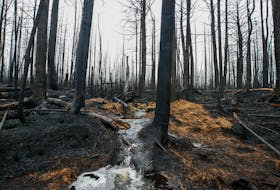BY DAN KRAUS
GUEST OPINION
Canada has been losing and saving species for a long time. Since European settlement, over 100 species have been lost here. These include plants and animals that are extinct and extirpated, and species that are considered historic - no one has seen them in Canada for a long time. Today, June 5, (World Environment Day) is a good time to reflect on species at risk issues.
In the Great Lakes region of southern Ontario, there are extinct species (passenger pigeon), extirpated species (paddlefish) and historic species (Eskimo curlew). There are also species that have vanished from this landscape but still exist elsewhere in Canada. This includes large carnivores, such as black bear and cougar, and also plants and smaller wildlife, such as white prairie-clover, spring salamander and Melissa blue butterfly.
The causes of species loss in Canada have varied through time, and include over-hunting, pollution, invasive species, habitat loss and climate change. These mirrors the threats to species around the world. Canada has made significant progress in reducing some of these threats, and helping some species to recover.
Over a century ago, many of our game and furbearing animals, such as pronghorn, beaver and marten, had vanished from huge areas of Canada because of unregulated hunting and trapping. Many migratory birds were becoming rare because of over-hunting and commercial harvest. Today, trapping and hunting are not a significant threat to endangered species in Canada. We have also seen an extraordinary recovery of species, such as wood duck and river otter.
Peregrine falcons and American white pelicans populations drastically declined in the 1970s, in part, because of the pesticide DDT would accumulate in these birds and cause the shells of their eggs to thin and crack. When DDT was mostly phased out by the mid-1970s, populations of these birds recovered. While there are still some chemicals that are impacting species, we now know that by reducing environmental pollution, species can recover.
Today our challenge to save species is also not simple, but it is equally necessary. Of all the threats to species and of all the factors endangering Canada’s wildlife, the challenge to our generation is stopping habitat loss.
Now, you might have thought climate change is our biggest challenge. But to save species, to prevent the further loss of Canada’s wildlife, we need to save habitat. There is no opportunity for wildlife to recovery if their habitat is lost. Changes in hunting regulations couldn’t have saved pronghorns if there wasn’t any habitat left. And solving climate change won’t protect species if, in our race to reduce carbon emissions, their habitat disappears.
There are many important initiatives to protect habitat for endangered species and wildlife. Canada’s current target of protecting 17 per cent of our land and inland waters by 2020 will help us meet an important conservation milestone, but most of these new protected areas and conservation lands will be in our northlands. This is critical for woodland caribou and wolverines, but many of Canada’s most endangered species live in the southern areas of Canada where most of the land is privately owned. This is also a landscape that is under the most immediate threat. In many regions, we have a one-time opportunity for our generation to protect critical habitats for our most endangered plants and animals.
One of the most important roles of the Nature Conservancy of Canada (NCC) is to work with private landowners to protect habitat for species that are at risk of being lost from Canada. NCC now protects habitat for over 200 species that have been assessed as endangered, threatened or special concern by the Committee on the Status of Endangered Wildlife in Canada (COSEWIC).
Over the last two years, with support from the Government of Canada’s Natural Areas Conservation Program, NCC has documented over 20 new species of endangered wildlife on our properties.
Habitat is the lynchpin of wildlife conservation. We need to do more conservation and we need to do it faster. No one else can save Canadian wildlife except Canadians.
- Dan Kraus is senior conservation biologist with the Nature Conservancy of Canada









